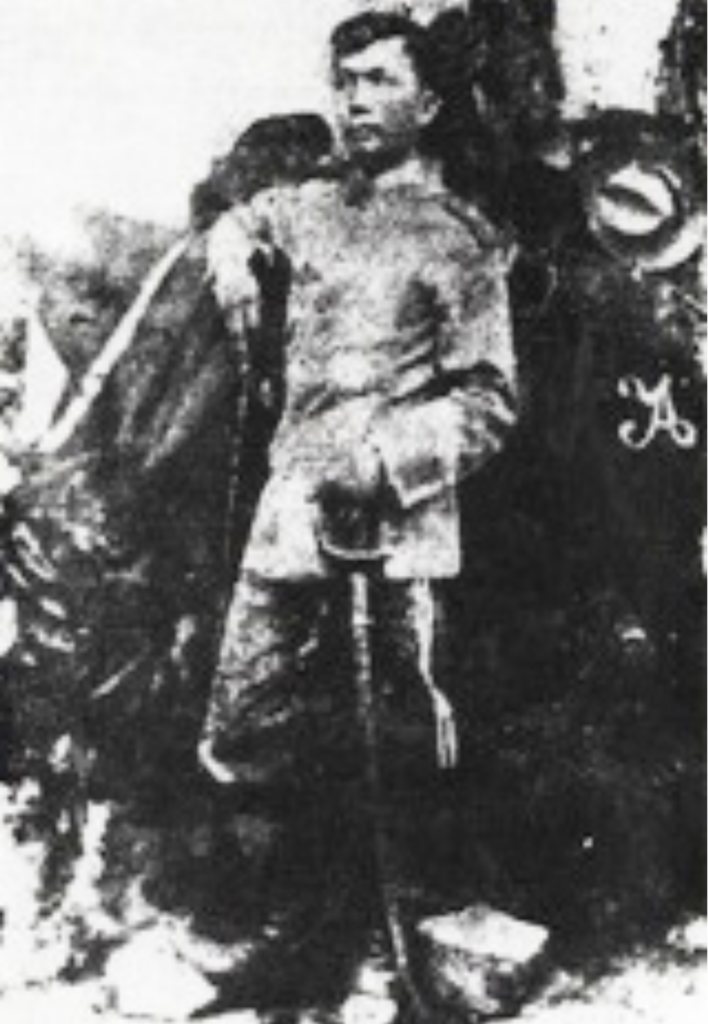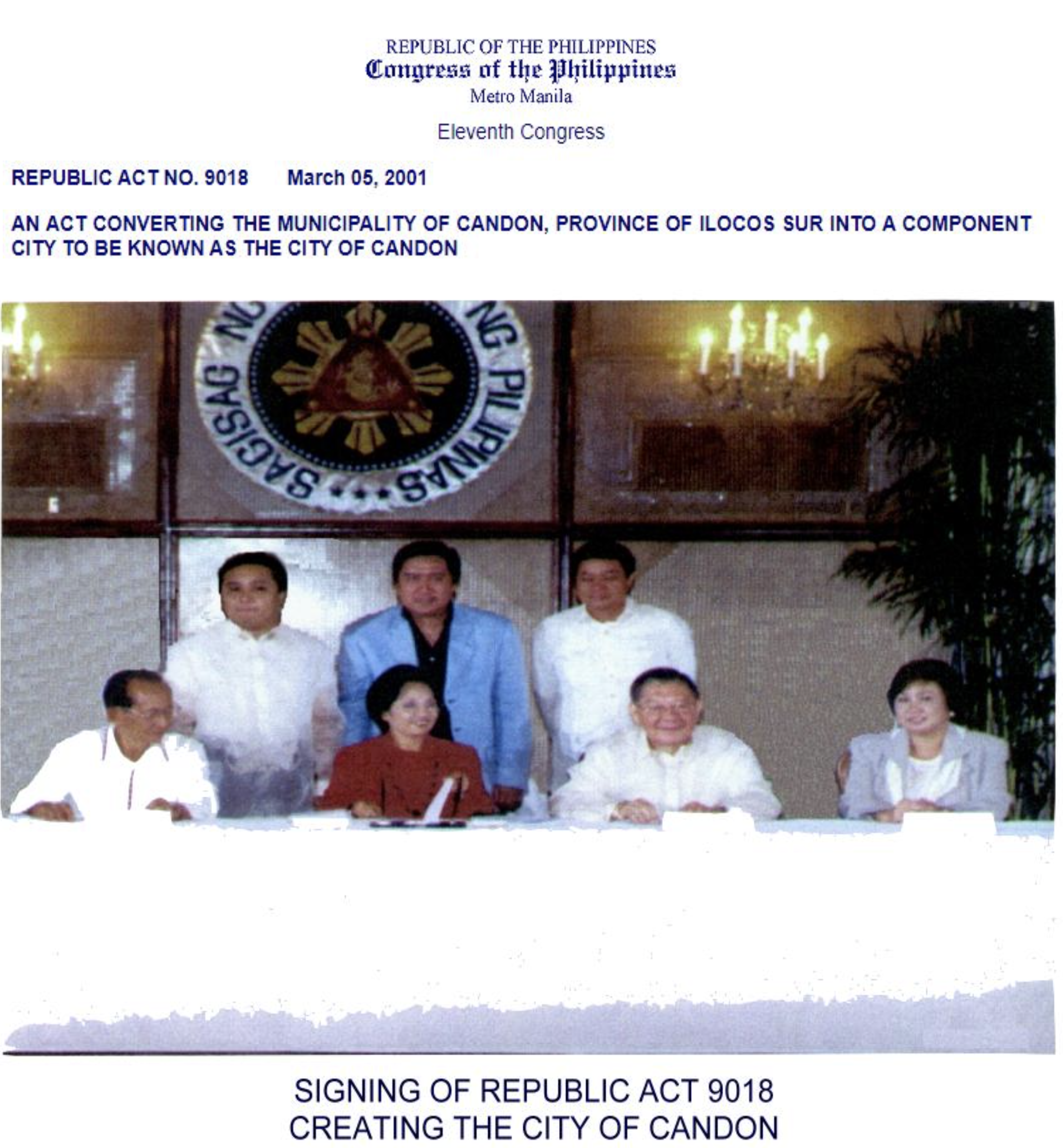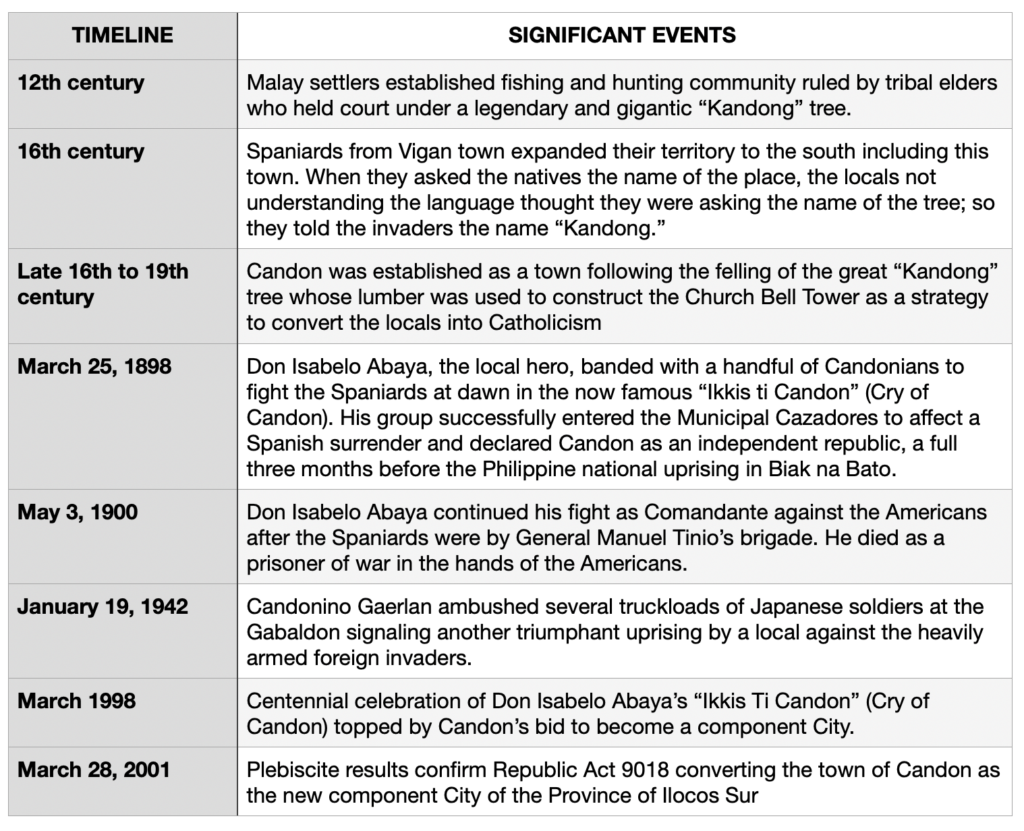LOCAL HISTORY OF CANDON
Etymology
The word “CANDON” comes from “Kandong,” the name given by the natives to a big tree in the village around which life, culture and beauty centered.
This village, so the legend says, was ruled by three local chieftains: ABAY-A, MADALANG and KALINIO. Madalang chose as his abode the shade of this gargantuan tree and lived there with his only daughter, the beautiful Ineng. Abaya and Kalinio for their part lived with their tribes in caves somewhere in Kadanglaan and Kauplasan, respectively.
“I am growing old fast, Ineng,” Madalang said to his daughter. “One day I wish to see you married before Kabunyan calls me to the great beyond. But my child, I would only want a son-in-law who could defeat me in “Gabbu” (wrestling). What do you say, Ineng?” Ineng could only answer sobbing, “I submit to your wishes, dear father.”
And so one day, after the “Kaniaw” was over, the sound of gongs, cymbals and gangza intermingled and reverberated far and wide. Subsequently, the ruling junta composed of elders issued the announcement regarding the wrestling competition.
It was Abaya who first took the challenge. At the sound of the cymbal, the protagonists fought savagely like wild beasts. By some bad luck, Abay-a in his unguarded moment stumbled over a root of a Kandong Tree and lost his balance. Madalang took advantage of the situation and mercilessly sent Abay-a reeling to the ground with several broken ribs. That was the end of the bout.
Three weeks passed, and this time, Kalinio who was reputed to possess extraordinary strength took up the challenge. Just then, a crow going for its mate flew carelessly overhead as if to augur the impending disaster that would follow. Moments later, the fight began and both protagonists stood their grounds, and each manifested signs of being victorious.
Madalang who was reputed to be the strongest man in the village, tried his old ruse to send Kalinio off balance but was outwitted by his elusive foe. At the end, Kalinio emerged as the winner. So Ineng was married to victorious Kalinio.
Just as the celebration was going on, the Spanish conquistadores, who were on their way to colonize Northern Luzon, passed by and attacked the merrymakers. Some offered futile resistance, while others fled in confusion and fear.
Subsequently, the friars assigned in this village ordered the cutting of the Kandong Tree and in its place was planted the first cross of evangelization. The timbers taken from the tree were used in the construction of the first Roman Catholic Church in the 16th century.
According to tradition, when the colonizers set foot upon this place and inquired as to its name, the natives answered, “KANDONG,” referring to the tree. Since that time on, the place came to be called CANDON.
Creation of the Municipality
The municipality was created in 1780 upon the installation of the first civil government under the Cabeza de Barangay, Don Juan P. Madarang by His Eminence, D. Mariano de Conquera, an Agustinian Friar.
Like other towns, Candon has its own history and foremeost among them is the Candon uprising popularly known as the “IKKIS TI CANDON,” as a response to the abuses and oppression perpetrated by the Spaniards.
The failure of the “Cry of Pugad Lawin” and “Pact of Biak-na-Bato” prompted Don Isabelo Abaya to organize a revolutionary group in preparation for the renewal of hostilities.
However, the premature discovery of the plot forced the revolutionaries to act swiftly and on March 25, 1898, the revolutionaries declared war against the Spaniards and established a revolutionary government in Candon.
Upon learning that the revolutionaries were busy conquering more towns, the Spaniards sent shock troops (CAZADORES) to re-occupy Candon.
The town fell due to the numerically superior and better armed Spanish soldiers. Most of the leaders and participants in the uprising who surrendered were arrested and were summarily executed.
During the Japanese occupation, the gallant exploits of Candonino V. Gaerlan demonstrated the bravery and patriotism of the Candonians. In 1942, with a handful of followers, he staged an ambush and subsequently destroyed the Alambique steel bridge to impede the advancement of the enemies. Several truckloads of Japanese forces and supplies perished along the national highway. In retaliation, however, the remnants of the Japanese soldiers razed the town proper in January 1942 resulting in what is considered the greatest conflagration in the history of Candon. Also, countless atrocities were committed by the Imperial Forces in the Gabaldon School until November 1944.
Local Events in Retrospect
The cemetery yard in the Catholic Church located south of the Poblacion area was constructed in 1797. Famine swept through the town from 1881 to 1882. A swarm of locusts never known in the history of Candon plagued the place in 1890. The tragic cholera epidemic took place in the year 1902. The cogon roofing of the church tower was burned in 1750.
R.A. 9018: The City of Candon

After the very successful celebration of the 100th Anniversary of the historic “Cry of Candon” in 1998, Congressman Eric D. Singson filed a bill in the 10th Congress seeking to convert the Municipality of Candon into a component city of Ilocos Sur.
At that time the province of Ilocos Sur still had no city. Candon, being the foremost trading center in the second district of Ilocos Sur, showed great potential in leading the locality with economic progress and social development.
Already a 2nd Class Municipality with an average income of P42 Million, Candon’s conversion into a city would mean more progress and development for the Candonian people and for the Province of Ilocos Sur. So a vigorous campaign was launched in both houses of congress. Unfortunately, the aspirations of the people for their beloved Candon to become the first city of Ilocos Sur were frustrated by some opposition and politics.
In the 11th Congress, then Congresswoman Grace G. Singson re-filed the Candon Cityhood bill and eventually succeeded to have it passed into law as R.A. 9018.
In a plebiscite conducted on March 28, 2001, RA 9018 was ratified overwhelmingly by the people of Candon. On May 5, 2001, R.A. 9018 was signed by Her Excellency President Gloria Macapagal Arroyo and House Speaker Sonny Belmonte at the Malacañang Palace.
To this day, the City of Candon maintains a steady course of progress and development as the recognized leader in the second District of Ilocos Sur. Banking on a well-educated, highly-competitive and hardworking citizenry, under the leadership of efficient and honorable city officials, Candon has earned its titles as the “Premier City in Southern Ilocos”, “Heart of Ilocandia”, Gateway to the Cordilleras and Ilocos”, and the uncontested “Tobacco Capital of the Philippines.”
Historical Timeline

